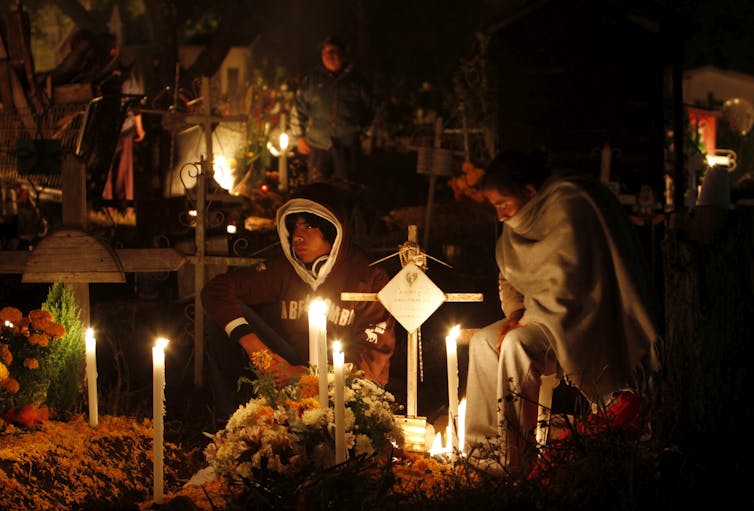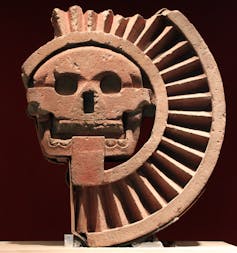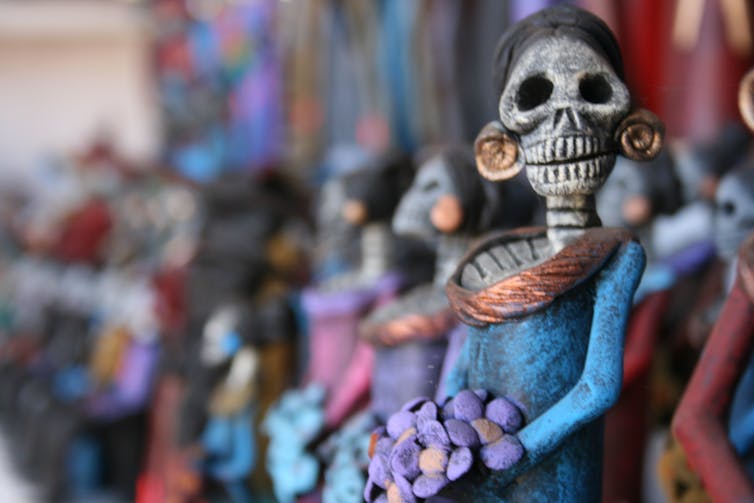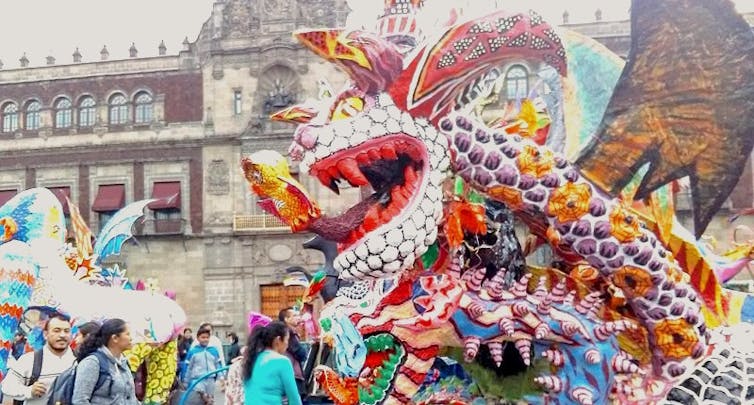
Experts in autocracies have pointed out that it is, unfortunately, easy to slip into normalizing the tyrant, hence it is important to hang on to outrage. These incidents which seem to call for the efforts of the Greek Furies (Erinyes) to come and deal with them will, I hope, help with that. As a reminder, though no one really knows how many there were supposed to be, the three names we have are Alecto, Megaera, and Tisiphone. These roughly translate as “unceasing,” “grudging,” and “vengeful destruction.”
I’m staying away from the impeachment except to throw in details (mostly ones that stand out to me but are presented in the background), since it’s being so well covered by TC and his sources.
El Día de los Muertos is an important holiday here in the Southwest, and here we have the Colorado Springs Philharmonic presenting (I don’t think anyone else but me calls it this, but it feels right) a karaoke concert – the movie “Coco” will be screened with the musical score removed and replaced by a live performance of it by the orchestra – something that is gaining in popularity in classical music, and not just with silent films, obviously ( think the last one the CSP did was “Star Wars.”) But I digress.
There’s a lot of misunderstanding about El Día de los Muertos, even here, and especially about its history and roots. As Ms. Farah points out, we don’t really know that it was “Aztec,” just that its roots come from an area conquered by Aztecs (Not everything in the Roman Empire was Roman. More recently, not everything in the Austrian Empire was Austrian.) So I thought it might be a good day to look at it, and think about it, along with lost knowledge in general.
==================================================================
Day of the Dead: From Aztec goddess worship to modern Mexican celebration
Kirby Farah, University of Southern California – Dornsife College of Letters, Arts and Sciences
Day of the Dead might sound like a solemn affair, but Mexico’s famous holiday is actually a lively commemoration of the departed.
The nationwide festivities, which include a massive parade in Mexico City, typically begin the night of Oct. 31 with families sitting vigil at grave sites. Mexican tradition holds that on Nov. 1 and 2, the dead awaken to reconnect and celebrate with their living family and friends.
Given the timing, it may be tempting to equate Day of the Dead with Halloween, a ghost-themed U.S. holiday. But the two holidays express fundamentally different beliefs.
While Halloween has its origins in pagan and Christian traditions, Day of the Dead has indigenous roots as a celebration of the Aztec goddess of death.

AP Photo/Marco Ugarte
Mictecacihuatl, goddess of death
Day of the Dead can be traced back to the native peoples of central and southern Mexico, the regions where I conduct my archaeological research.
When the Spanish arrived in central Mexico 500 years ago, the region had millions of indigenous inhabitants. The conquistadores largely characterized them as Aztecs because, at the time, they were united under the expansive Aztec empire.
According to colonial period records, the Aztec empire was formed in A.D. 1427, only about a century before the arrival of Spanish . But the celebration that Mexicans now call Día de los Muertos almost certainly existed many centuries earlier, perhaps originating with the Toltec people of central Mexico.
In any case, by the time the Spanish conquistadors invaded in 1519, the Aztecs recognized a wide pantheon of gods, which included a goddess of death and the underworld named Mictecacihuatl. She was celebrated throughout the entire ninth month of the Aztec calendar, a 20-day month that corresponded roughly to late July and early August.

Anagoria/National Museum of Anthropology of Mexico, CC BY-SA
Aztec mythology tells that Mictecacihuatl was sacrificed as a baby and magically grew to adulthood in the underworld, where she married. With her husband, she presided over the underworld.
Mictecacihuatl – who is often depicted with flayed skin and a gaping, skeletal jaw – was linked to both death and resurrection. According to one myth, Mictecacihuatl and her husband collected bones so that they might be returned to the land of the living and restored by the gods.
The Aztecs appeased these fearsome underworld gods by burying their dead with food and precious objects.
Archaeologists and historians know relatively little about the details of the month-long celebration of Mictecacihuatl, but say it likely involved burning incense, song and dance, and blood sacrifice – customary practices in many Aztec rituals.
Blending cultures
The Spanish invaders of Mexico were Catholic, and they worked hard to evangelize native peoples. To stamp out lingering indigenous beliefs, they demolished religious temples, burned indigenous idols and destroyed Aztec books.
But indigenous people in Mexico, as across the Americas, resisted Spanish efforts to eradicate their culture. Instead, they often blended their own religious and cultural practices with those imposed on them by the Spanish.

Alfonso Martorell/Culture and Tourism Secretary of Morelia
Perhaps the best-known symbol of the ethnic and cultural mixing that defines modern Mexico is La Virgen de Guadalupe, a uniquely Mexican Virgin Mary.
Many Mexican Catholics believe that in 1531 the Virgin appeared to Juan Diego, an indigenous Mexican farmer, and in his native language of Nahuatl told him to build a shrine to her. Today the Basilica of Our Lady of Guadalupe in Mexico City is among the world’s most visited holy sites.
Day of the Dead is almost certainly a similar case of blended cultures.
Spanish conquerors faced difficulty in convincing native peoples to give up their rituals honoring death goddess Mictecihuatl. The compromise was to move these indigenous festivities from late July to early November to correspond with Allhallowtide – the three-day Christian observance of All Saints’ Eve, All Saints’ Day and All Souls’ Day.
With this move, the holiday was nominally connected to Catholicism. But many practices and beliefs associated with the worship of the dead remained deeply indigenous.
Día de los Muertos today
Contemporary Day of the Dead rituals were featured prominently in the 2017 Disney/Pixar film “Coco.” These include homemade sugar skulls, decorated home altars, the fantastical spirit animals called alebrijes and images of convivial calaveras – skeletons – enjoying the afterlife in their finest regalia.
The use of Mexican marigolds to adorn altars and graves on Day of the Dead probably has indigenous origins. Called cempasúchil by the Aztecs, the vibrant Mexican marigold grows during the fall. According to myth, the sweet smell of these flowers awaken the dead.

Juancho Lorant/Wikimedia, CC BY-SA
The elaborately decorated shrines to deceased loved ones, which usually contain offerings for the dead, may also have pre-Hispanic origins. Many indigenous peoples across Mesoamerica had altars in their houses or patios. These were used to perform household rituals, worship gods and communicate with ancestors.
The bones, skulls and skeletons that are so iconic of Day of the Dead are fundamentally indigenous, too. Many Aztecs gods were depicted as skeletal. Other deities wore bones as clothing or jewelry.
The Aztecs, who engaged in ritual human sacrifice, even used human bones to make musical instruments. The Aztec capital city of Tenochtitlan had a large bone rack, called a tzompantli, that stored thousands of human skulls.
And when Aztec commoners buried deceased family members under their own houses to keep them close, Mictecacihuatl became the formidable guardian of their bones.
That’s good reason, the Aztecs would say, to celebrate this goddess of death with breads, flowers and a killer three-day party.
This story has been updated to more accurately characterize the origins of Halloween.![]()
Kirby Farah, Lecturer of Anthropology, University of Southern California – Dornsife College of Letters, Arts and Sciences
This article is republished from The Conversation under a Creative Commons license. Read the original article.
==================================================================
One person in the comments was excited, having long seen parallels between El Día de los Muertos and the Japanese festival O-bon, to learn that the pre-Columbian festival was longer than a day or three, and was originally in late summer – both characteristics of O-bon. (This leads to the question, when exactly did people from Asia cross that no-longer-existing land bridge, and from where in Asia?) I’m not qualified to go there, so I won’t, but it makes one think.
Alecto, Megaera, and Tisiphone, help us to stay open to learning about other people, and about their history and customs – when we do, we so often find how much more alike we are than different.
The Furies and I will be back.

8 Responses to “Everyday Erinyes #190”
Sorry, the comment form is closed at this time.

Gosh, what a fascinating, and educational read!!
I am going to share also.
Growing up Catholic, and living in the NE, we knew it to be 11/01 – All Saint’s Day + 11/02 – All Soul’s Day.
Went to Mass on both days, and that was about it. lol
Moving to AZ years ago, I found the Hispanic version much more family involved. A good learning experience too.
I like that.
Thanks, Joanne, great post!!
Illuminating, including a story of what becomes history or tradition and why. Thanks Joanne.
Very interesting, JD.
While I don’t think we can use the commonality between Asian and Native American beliefs to argue the time of the land bridge, I do think that the beliefs that the dead live on in the afterlife and that we can interact with them come down from the roots of both regions.
Well, our brains are wired for magical thinking – which means that it must have some kind of survival value – and wired in very specific ways. It’s perfectly reasonable for similar ideas to arise seemingly independently (i.e., geographically independently, but connected by similar brain wiring.)
That makes sense to me, but the Ellipsoid Orb rules all.
Interesting article.
I like Pat grew up Catholic and remember November 1 as All Saint’s Day and November 2 as All Soul’s Day. We attended mass both days.
Fascinating to watch how you showed the way Mexico and other countries celebrated it.
Thanks Joanne
Thanks for a very interesting read, Joanne.
Very informative article about something that I only had a passing knowledge of.
And WRT your “Not everything in the Roman Empire was Roman. More recently, not everything in the Austrian Empire was Austrian.” – When republicans try to call AOC or Warren “socialists” like Hitler because that word is in the Nazi name, my favorite rejoinder is DRPK …
Names can be very deceiving. Sen. Warren is NOT a “socialist” akin to Hitler just because that word is in “Nazi”. The same as the Democratic People’s Republic of Korea is neither democratic, nor the people’s, nor a republic.